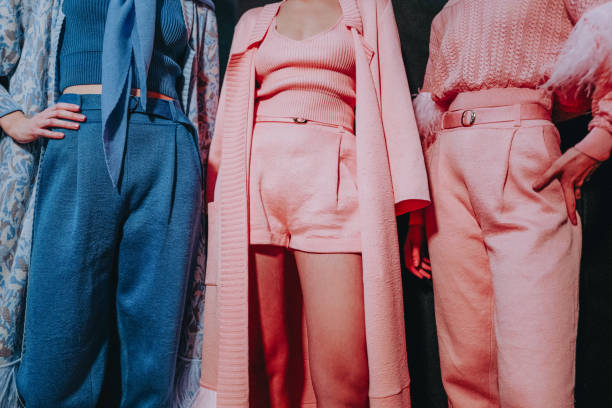
Fast fashion and slow fashion represent two fundamentally different approaches to clothing production and consumption. Fast fashion is characterized by rapid production, mass-market appeal, and low cost, whereas slow fashion emphasizes sustainability, ethical labor practices, and quality over quantity. Understanding the differences between these two paradigms is crucial for making informed choices as a consumer.
Understanding Fast Fashion

Fast fashion is a term used to describe the rapid production of inexpensive clothing collections that are inspired by the latest runway trends. Brands like Zara, H&M, and Forever 21 are notable for their ability to bring new styles to market quickly and at low prices. This model relies on a quick turnaround from design to retail, often within weeks.
The main advantage of fast fashion is its affordability and availability. However, this comes at a significant cost to workers and the environment. Factories producing fast fashion items often operate under poor working conditions and pay low wages. The heavy use of synthetic materials and chemicals also poses environmental hazards.
The Environmental Impact
One of the most pressing issues associated with fast fashion is its detrimental impact on the environment. The industry is notorious for its massive water consumption, significant carbon footprint, and the release of harmful chemicals into ecosystems. Fast fashion brands often use cheap, non-biodegradable materials that contribute to landfill waste and ocean pollution.
According to research, the fashion industry is responsible for 10% of global carbon emissions, a figure that is exceedingly high for any single sector. The production of synthetic fibers like polyester requires large amounts of fossil fuels, further exacerbating the environmental toll.
What is Slow Fashion?
Slow fashion is an alternative approach that prioritizes quality, sustainability, and ethical labor practices over rapid production and low costs. This movement advocates for thoughtful consumption and encourages consumers to buy fewer, but higher-quality, items. Brands such as Patagonia, Eileen Fisher, and Reformation are key examples.
Unlike fast fashion, slow fashion brands often source organic or recycled materials and employ skilled artisans who are paid fair wages. The emphasis is on producing timeless, durable pieces that can be worn for years, rather than fleeting trends that are soon discarded. This sustainable approach aims to minimize waste and lower the overall environmental impact.
The Benefits of Slow Fashion
One of the primary benefits of slow fashion is its focus on sustainability. By opting for natural and recycled materials, these brands reduce their environmental footprint. The slow fashion movement also promotes transparent and ethical supply chains, ensuring that workers are treated fairly.
Another notable benefit is the emphasis on quality and durability. Slow fashion items are designed to last, which encourages consumers to invest in pieces they can wear repeatedly over the years. This approach not only saves money in the long run but also fosters a more meaningful relationship with the clothes we wear.
Making the Switch: How to Support Slow Fashion
Transitioning from fast to slow fashion is a meaningful way to support sustainability and ethical labor practices. Here are some actionable steps to make the switch:
- Research brands that prioritize sustainability and fair labor practices.
- Invest in high-quality, timeless pieces instead of trendy, disposable items.
- Buy second-hand or vintage clothing to reduce waste and support circular fashion.
- Learn basic clothing repair skills to extend the life of your garments.
- Support local artisans and small businesses that focus on ethical production methods.
Making informed choices and adopting a mindful approach to shopping can significantly impact the environment and the lives of garment workers worldwide.
Conclusion
Fast fashion and slow fashion represent two distinct models in the clothing industry, each with its advantages and downfalls. Fast fashion offers affordability and trendy pieces at the cost of ethical and environmental concerns. In contrast, slow fashion promotes sustainability, ethical labor practices, and high-quality designs. As consumers, our choices can drive change. By opting for slow fashion, we can contribute to a more sustainable and equitable world.
FAQs
What is the main difference between fast fashion and slow fashion?
Fast fashion focuses on rapid production and low costs, often resulting in poor working conditions and environmental harm. Slow fashion emphasizes sustainability, ethical labor practices, and quality over quantity, aiming for a reduced environmental impact and better working conditions for garment workers.
Is slow fashion more expensive than fast fashion?
Initially, slow fashion items may appear more expensive due to higher production costs and quality materials. However, because these items are designed to be durable and timeless, they often provide better value over time, reducing the need for frequent replacements.
Can fast fashion be sustainable?
While some fast fashion brands are making efforts to adopt more sustainable practices, the fundamental model of rapid production and disposable fashion inherently poses challenges to true sustainability. Changes in material choices and production methods can mitigate some impacts, but the model itself remains problematic.
What are some sustainable materials used in slow fashion?
Some sustainable materials commonly used in slow fashion include organic cotton, hemp, bamboo, Tencel, and recycled fabrics. These materials generally have a lower environmental impact compared to conventional cotton and synthetic fibers.
How can consumers support the slow fashion movement?
Consumers can support the slow fashion movement by buying fewer, higher-quality pieces, opting for second-hand or vintage items, supporting brands that prioritize ethical production, and learning to repair and care for their clothing to extend its life.




